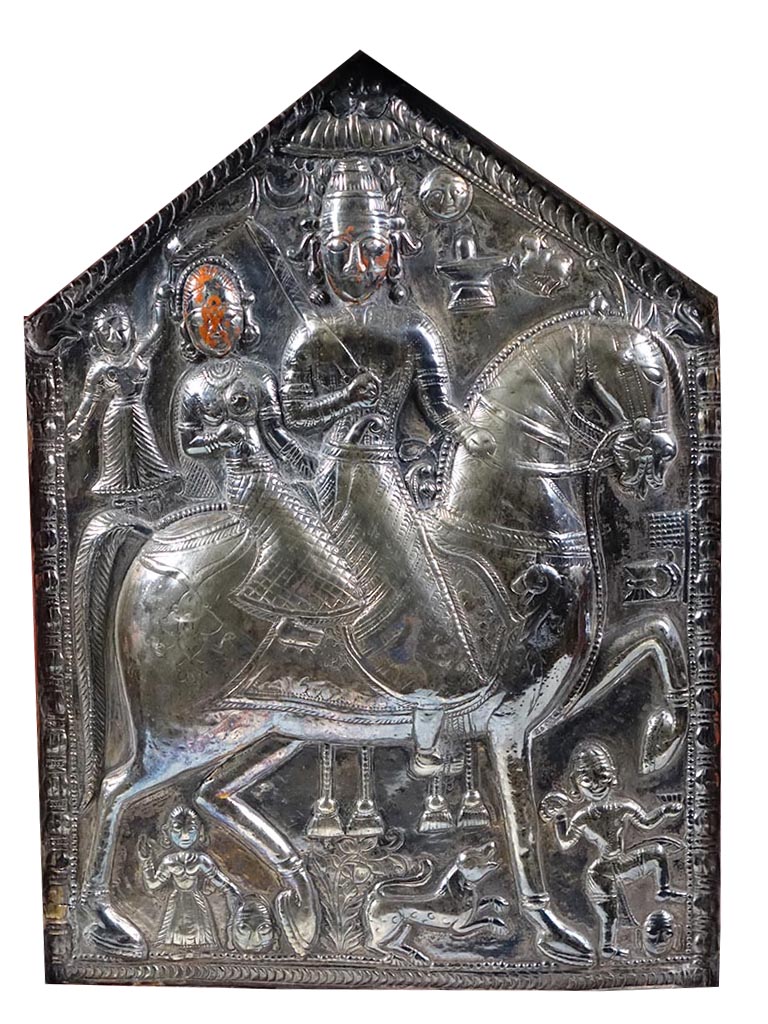
02 Jul NEW PROPOSALS JULY 2024
Two female figures
South India – Tamil Nadu
17th-18th century
Bronze, lost wax process
cm. 41 and cm. 29
Price on request
The statue on the left, with a high hairstyle and on a pyramidal base, probably represents the goddess Lakshmi with a lotus flower and a jar, although in South India deities often take on different names than the traditional ones. The hairstyle (makuta) and the pomp of the jewelry also confirm her divine quality. The body is slender, well-shaped, and both the tight-fitting robe and the elongated shape of the hairstyle accentuate its momentum, projecting it into a heavenly dimension. The statue on the right with the offering plate, marked features, and broad shoulders looks like a queen, especially since the chignon on the nape of her neck makes her a “worldly” figure. A feeling of popular strength prevails here while in the other, a sense of hieratic spirituality. They both have the same style and patina and easily come from the same temple or workshop. Their threadlike form is reminiscent of that of some bronze figures from the Puddokhotai area (published separately).
Group of bidders and motherhood
India, Tamil Nadu, Pudukkotai area
17th / 18th century
Bronze, hollow cast
H. 14/15 cm
Price on request
Who are these threadlike, almost proto-Giacometti figures towering with offerings in their hands and gazing into infinity? They come from Tamil Nadu, and more specifically from the Pudukkotai area. Perhaps they are local deities placed on the household altar or even temple offerings, or perhaps they are ex-votos as tangible thanks for a motherhood granted or a grace received. They show a popular but refined taste in the stylization of forms and in their elegant simplicity.
The former funerary tombs in Indonesia and Philippines often contained beaten gold covers of the deceased high-rank people as the symbols of their social status. The masks might cover the entire face or simply underline the subject’s main features. The use of gold was very important in order to guarantee the deceased’ safe passing into the afterlife and had also the purpose of reassuring the soul, thus avoiding from disturbing the livings wandering in the world.
Khandoba with Mhalsa
Karnataka or Tamil Nadu
19th century
Repoussé silver and coeval frame
Cm 24.5 by H 33.5 (only plaque) – Cm 39.9 by H 49 (with frame)
Price on request
The two sumptiously dressed gods ride an equally lavishly harnessed horse. Khandoba holds the sword and carries a dagger in his belt; to his left Nandi and a Linga can be seen, both symbols of Shiva, of whom he is a manifestation. The plaque is covered in symbols and human figures: on top a handmaid is using a fly-whisk, at bottom left a woman seems to be supporting a head whilst on the right a male figure is trampling upon another body. Between the horse’s legs a dog rises on its hind legs as if barking against some danger. The two gods’ faces still bear traces of the ritual color that used to be applied to sacred statues. The plaque is mounted in a wooden frame terminating in a kirtimukha head, a typical animal in Indian mythology.
Bodhisattva
Art of Gandhara
Central Asia
4th / 5th century
Raw earth with pigments
H. 29 cm
Price on request
The bodhisattva, recognizable by the halo surrounding his head, is seated in the “royal” position (royal ease), symbolizing his readiness to come down from the throne on which he is seated to help those who invoke him. His head adorned with a rich crown and heavy earrings is tilted slightly to the left and looking down; his hands hold an offering plate. The style of the sculpture, decorated with pigments that emphasize the volumes, is reminiscent of some earthenware works from Central Asia.
The bodhisattva Maitreya
Art of Gandhara, North Pakistan
2nd/3rd century
Schist
H. 23.5 cm
Prov. Private collection, Torino, Italy
Price on request
Despite the lack of a left arm, the body setting and raised right arm allow this torso to be identified as the bodhisattva Maitreya. It has a bare chest adorned with necklaces and prayer beads of Iranian origin. The lower robe wraps the body from the hips to the ankles and gathers over the left leg with rich drapery.
Architectural frieze
Art of Gandhara
2nd/3rd century
Schist
H. 62 cm
Prov. Private collection, Torino, 1994
Price on request
The frieze was a part of the lateral decoration of a portal or a niche. Seven panels show always the same image: two devotees and the Buddha in the gesture of removing the fear (abhayamudra). At the left side, the frieze is completed by eleven erotes in two different postures and by a frame made up of lotus leaves. In the Art of Gandhara, the repetition of the Buddha image psychologically strengthens the convincing power of his doctrine. Published: Galleria Mandala, Grecia e India: the art of Gandhara.
The large stupas scattered throughout the valleys and mountains of Gandhara were decorated with series of bas-reliefs of a devotional or didactic nature illustrating the most significant moments in the Buddha’s life and the miracles he had performed, as is probably the case in this relief (as seems to be the case here). Three pillars with Corinthian capitals divide the architectural structure into two parts, where the Enlightened One appears in the center of each, accompanied on his left by Vajrapani holding a stylized vajra.
The various figures approaching the Buddha appear to be making offerings to him, but the attention he manifests could also indicate the fulfillment of a request and thus a miracle. When the theme of these countless bas-reliefs cannot be deciphered because they are not described by the texts, they are simply called genre. The scenes are carved with effective naturalism, each figure, even that of the Buddha, has a different attitude, with a spontaneity that could be described as almost theatrical. The gazes all cross in different ways and question each other in a happy overall picture.
A Bull
Central India, Bastar area (?)
19th century
Bronze, lost wax process
14 by 10 by H. 15 cm
Price on request
Do you know the bull of the Indus Valley seals or even the one published here from central India, both from the second millennium B.C.? Even then this mighty, fertilizing animal belonged to the world of the sacred, and soon the Vedic religion (proto-Hinduism) enshrined it by associating it with Prajpati-Shiva. So is not this bronze bull so essential in its massive form reminiscent of the much older one? The animal, partly covered with the colored substances used during rituals, is placed in the center of a platform with wheels, but it is not a toy it is a mobile altar symbolizing a sacredness that can be carried along village streets: it is a mythical image.
































No Comments